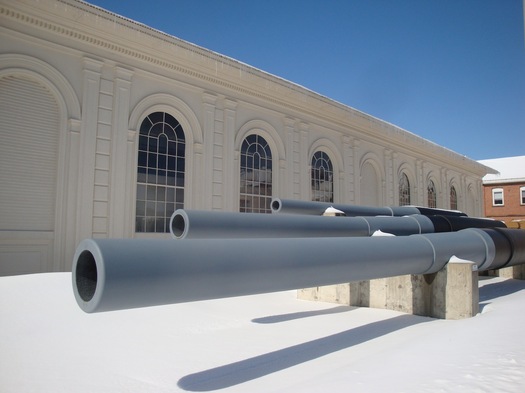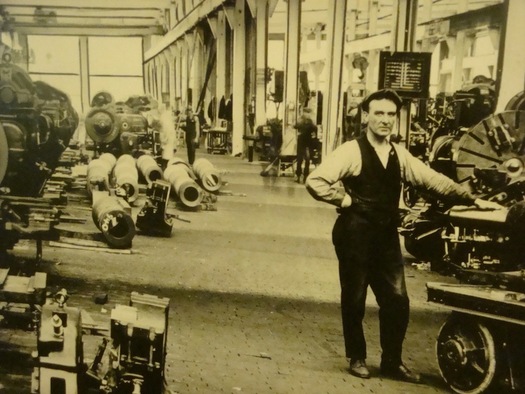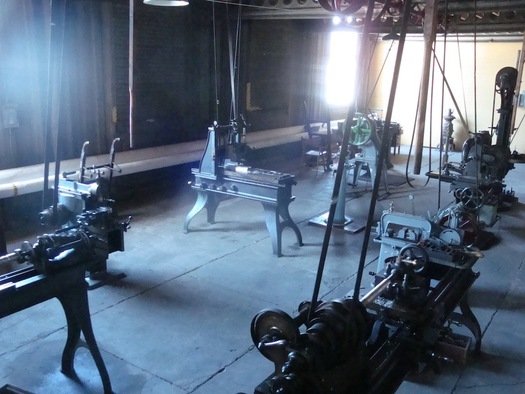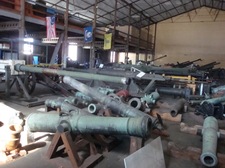Industry, history intertwine at the Watervliet Arsenal Museum

Not all the exhibits fit inside.
Talk about the Watervliet Arsenal and you'll find yourself using a lot of superlatives: first, only, oldest. Founded in 1813, it's the United States' oldest continuously active arsenal. It's still an active manufacturing and development site today -- and the Capital Region's 14th largest employer. Watervliet Arsenal has been a part of local life for nearly 200 years, employing thousands. Its museum, which is free and open to the public, gives us a glimpse of our industrial past.

It's worth going to the museum just to see the building itself. Built in 1859 as a storehouse, it's a beautiful example of cast-iron construction. Many buildings have cast-iron facades, but this one is made almost totally of pre-fab cast iron. The museum describes it as the largest remaining free-standing cast-iron structure in the United States. The graceful arches present an interesting contrast to the tanks parked outside.
 The museum's collection covers two areas: the history of cannon and the history of the arsenal. Within the next two years, the museum hopes to shift its focus more squarely onto the arsenal itself. And in truth it does look ripe for an upgrade: A number of the exhibits are a bit tired and faded. If you're interested in the development of breech-loading cannon, you'll be most engaged. Me, I'll look forward to when they present more information on the history of the arsenal as a manufacturing plant and the people who worked there over the centuries.
The museum's collection covers two areas: the history of cannon and the history of the arsenal. Within the next two years, the museum hopes to shift its focus more squarely onto the arsenal itself. And in truth it does look ripe for an upgrade: A number of the exhibits are a bit tired and faded. If you're interested in the development of breech-loading cannon, you'll be most engaged. Me, I'll look forward to when they present more information on the history of the arsenal as a manufacturing plant and the people who worked there over the centuries.

Still, what they have on the arsenal is very interesting. The museum tells good stories about how this place interwove with local lives.
For most of its first century the arsenal made things like gun carriages, cartridges, saddles, scabbards and other equipment. In the 1880s, it became the first U.S. government cannon factory.
Children were employed at the arsenal during the Civil War, rolling paper cylinders for cartridges. Boys were hired to do this job, but when a heavier cartridge came into use, they had to switch to using linen to make the cylinders, and the boys couldn't seem to get the hang of the new material. They brought in girls, who could do it much better. More than eighty years later, one of these girls remembered her work at the arsenal:
"I was nine years old and all of us little girls sat on a long bench, our feet not quite touching the floor, and we filled cartridges all day long. When we finished one we'd put a little glue on the end of it and fasten it in a box set there for us. I worked from seven in the morning until six at night."
There's also the story of Norwegian-born Carl Alfred Christiansen, a machinist who became head of the project to develop a 16-inch gun. Christiansen died the day before the gun was successfully test-fired, a victim, newspapers said, of "exhaustion." Now he's a member of the Ordnance Hall of Fame.
A collection of photographs and text describes the early life of Stephen Vincent Benet, twice a winner of the Pulitzer Prize for poetry, who spent time at the arsenal, where is father and grandfather were both officers. You can see Benet as a little boy posing for a picture in the breech of Christiansen's first 16-inch gun. Benet Laboratories, the arsenal's research and development facility, is named for the poet's grandfather.
But the best thing of all, and the reason you should go, is in the back room.

Along one side of the huge, unheated space is set up an early 1900s-era machine shop. It's all metal and gears, leather belts and Industrial-Age innovation. These are the tools of our great-grandfathers' working lives. A few of the machines are even older, dating from the post-Civil War era. And most intriguing: The shop is operational. As long as the temperature's above 40, they can turn on the equipment and demonstrate it. When winter ends (if it ever ends), I want to go back to hear what it's like with all the belts spinning and the levers clanking.

 The floor of the rest of the airplane hangar-like back room is lined with rows of cannon from different eras, including one captured at the Battle of Saratoga. Just going in there has a fun backstage-access feeling to it.
The floor of the rest of the airplane hangar-like back room is lined with rows of cannon from different eras, including one captured at the Battle of Saratoga. Just going in there has a fun backstage-access feeling to it.
But the machine shop had me grinning from ear to ear. So much of our history that gets preserved is decorative: the chairs and jewelry and houses of the wealthy. Those things are beautiful, and it's good that they be protected. But they tell only one story about America's past. Me, I'm drawn to places that can show me something of the history of working-class life.
Visiting the museum.
Admission is free, but there are some procedures you'll have to follow. This is a military facility, after all.
- Make sure you have your photo ID and your car registration.
- Enter the arsenal by the south gate -- across from McIntyre's Pub on 3rd Avenue in Watervliet.
- Tell the gate guard that you're here to visit the museum. You'll be asked to park your car and step into the guard shack to sign in.
- The sign-in form will ask for your name, birthdate, citizenship, height, weight, eye color, and whether you "represent a foreign concern." And more.
- You'll be given a visitor's badge, as well as a slip of paper to have signed at the museum when you're done visiting. You'll turn both in again at the gate when you leave.
A note on photographs.
You're welcome to take photos in the museum. If you want to photograph any of the artifacts that are outside the museum, the docent will need to accompany you, as visitors are not free to wander the arsenal grounds with a camera.
Find It
Watervliet Arsenal Museum
800 3rd Ave.
Watervliet, NY 12189
The map marker shows, roughly, the location of the arsenal's south gate.
Hi there. Comments have been closed for this item. Still have something to say? Contact us.
Comments
To me, the old machinery itself is beautiful. It is often so much more than utilitarian. Look at the legs on the lathes for example. Incredible compound curves that today are straight rectangular boxes.
Next stop the industrial museum in S. Troy?
... said komradebob on Mar 9, 2011 at 1:57 PM | link
Is there any information available concerning cannons produced at Watervliet Arsenal? Our VFW Post would like information on a 7" cannon No. 48 with a weight of 1689 pounds. Inspector initials were JPF. Thanks
... said R Scheu on Jul 13, 2011 at 11:14 AM | link
also looking for info on a cannon. our vfw post in Wessington Springs S.D. has a cannon produced at Watervliet Arsenal.the markings on the end of the barrel 1898-829lbs,167 J.W.J No. 231 model of 1898 Rock Island Arsenal 1899.
any info. would be helpful we are have new whells made and would like to paint it the correct color. Thank You.B
... said Bernie Maxwell on Jul 21, 2011 at 7:59 AM | link
I am looking for information on a cannon that sits on the Fremont County Court House Lawn in Lander, WY. Markings include: Wt. 3710 lbs; E.L.H.; 1893 ;Watervliet Arsenal; 7 inches; No.4
It is a breech-loading cannon withe a rifle barrel.
Where might I look for background on this piece? Thank!s
... said Sylvia Rotroff on May 3, 2013 at 10:49 AM | link
My uncle William Stewart worked many years in the arsenal and was one of the workers on the fist 16 inch cannon. Maybe there are some photos of m uncle in the museum. I hope so!
... said John R. Stewart on Feb 2, 2016 at 10:08 AM | link